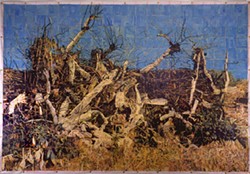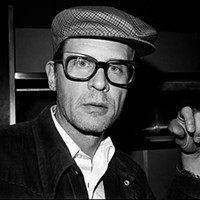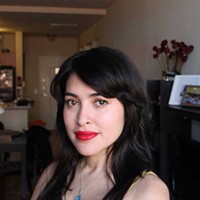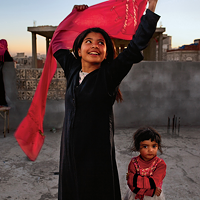2005 was the year of the rising sun for the visual arts in Charlotte. After seeing three galleries close at year's end 2004 and hearing the rude sounds of the mayor badmouthing the public art selections for the light rail, we woke to this past year dry-mouthed, hung-over and, understandably, a little pessimistic about 2005.
Lucky for us, the dealers, curators, directors and artists took a different tack. They ignored Hizzoner's raspberries and brought the feast to our table -- it was our job to partake.
This past year was a year of living large -- living large off the wisdom, pluck and beneficence of our dealers, curators, directors and ourselves. This past year, Charlotte bared an art-smitten public face, beaming brighter eyes and deeper pockets.
Oh, yes. And the artists led the way...
What was brought to our table this past year?
For starters, compassion and contrary opinions, courtesy of the Light Factory at Spirit Square. The most eloquent and irrepressible voices in our culture are always assimilated by the status quo, and the Light Factory was no exception. But our longest lived alternative community voice hasn't been tamed by its polished uptown digs and mainstream status. Assimilation has not mellowed the place into visual Muzak; it only conferred a bigger stage and broader audience to this resolute voice. The Light Factory is a sunlit soapbox for articulate civil dissent. Charlotte, you may advance one step.
The Factory delivered the mournful elegance of Phil Moody's Textile Towns, a photographic requiem to communal lives lost following the fall of our regional textile industries. Since midyear, Moody's work has trailed off behind my waking horizon line but returns, oversized and unsolicited, high gloss and wailing, in my dreams. Waking to his adopted communities' fading, throttled rasp is to be poked from sleep by a wailing hungry wolf.
The Light Factory also brought to whitewashed and parched eyes the inappropriate-for-prime-time images of Sights of War, an unflinching look at recent conflicts across the globe. On these walls for 40 days were graphic testaments to the human toll of conflict in Kosovo, Bosnia, Afghanistan, Rwanda, Baghdad and Chechnya. The desert burial of an Afghan child four years from his mother's womb will not be televised, nor will it be forgotten by those who witnessed the event through the lens of photographer Alexandra Boulat. The wars seen here, and the ones before and to come, will be followed by rationale and justification, but will never merit either reason or justice. This art documents that dull shame.
Five private galleries in Charlotte carried the torch for the quiet vacancies left last year following the disappearance of WDO, Blue Pony and Noel Gallery. Galleries Joie Lassiter, Hodges Taylor, Elder Art, Center of the Earth and Melberg provided high end delicacies each first and third Friday for us pavement stomping pabulum eaters. Each month, these galleries, each queens of their own neighborhood territories, serve up a new diet of sensitive, annoying, innovative and challenging sculpture, painting, prints and photographs. I commend the pluck and gall of these dealers of fine art. These men and women persevere year after year through cultural climates ranging from benign to hostile, with no public subsidies beyond the pockets and wisdom of kindred spirits. They are icons of capitalism -- making money, raising spirits, opening doors of perception. Each is Ayn Rand dancing on Soul Train.
Speaking of capitalism, let's talk about the fruits from corporate sugar daddies. This past year, Levine the Bountiful occupied the throne.
Two shows at Levine Museum of the New South in 2005 bridged that dangerously chilly water between the inspirational and the educational. I always balk at the prospect of learning something because it's good for me. Let me hazard a guess: I'm not alone. Two shows last year -- We're Still Here: American Indians in the South and Purses, Platforms and Power -- coaxed my timid legs across that rickety bridge.
In the first show, author Frye Galliard and photographer Carolyn DeMerritt disabused me of my vapid and clichéd stereotypes of American Indians in and around North Carolina. This show introduced me to the lawyers, students, healers and teachers whose ancestors introduced my ancestors to this country. My Anglovision stands recalibrated.
Purses, Platforms and Power rode me down Charlotte's bumpy Southern road paved by uppity Southern women in the 1970s. June Cleaver did not morph into Germaine Greer overnight. Many women in Charlotte worked the deeper-than-cosmetic miracle which led to a more equal representation in the political, professional and religious worlds of Charlotte. This city's first female state legislator was elected in 1976. Knowing that alone is worth the visit.
Other exceptionally bright stars in Charlotte's spangled year were the two Mints and the Burned Out Church.
The Mint Museum of Art delivered Chuck Close and Renaissance to Rococo. The Mint Museum of Craft + Design delivered Murano Glass and Don Reitz. 'Nuff said.
The McColl Center for Visual Art is an ongoing workshop for visual artists; it's a talent magnet for artists worldwide, ranging from the brilliant to the inscrutable. This past year's best -- and most important -- show was Contemporary Landscapes... Crossing Borders, which closes this Saturday. Curator June Lambla has solicited seven artists who reach hands into the sticky relationship between us human beings and our natural environment. It's riveting work issued from picky minds behind critical eyes. Eden appears imperiled.
One sour note to Charlotte's watershed cultural year: Our civil servants continue to throw themselves across the tracks of our train headed to the Promised Land. I've yet to receive good news on the Light Rail Public Art projects -- last I heard, the budget had been skinnied and a few projects canned. And moving the Mint uptown or building the Bechtler Museum with the help of the Arts and Science proposal? Another council meeting starts in 10 minutes.
The divide grows between our elevated cultural profile and our laughable public image. We'll soon be renowned for our cultural ascent as we're ridiculed for our political plunge, envied and scorned concurrently. Now that's a distinction not every city can claim.
Book Reviews 44
Latest in Visual Arts
More by Scott Lucas
Calendar
-
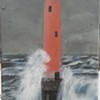
NEW WINDOW GALLERY-Pat Rhea-ACRYLIC PAINTINGS-April 05-30 2024 VALDESE, NC 28690 @ New Window Gallery/Play It Again Records
- Through April 30, 12 p.m.
-

WHISKEY TASTING: VIRGINIA HIGHLANDS WHISKY @ Elizabeth Parlour Room
-
An Evening With Phil Rosenthal Of "Somebody Feed Phil" @ Knight Theater
-
Kountry Wayne: The King Of Hearts Tour @ Ovens Auditorium
-
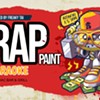
Trap & Paint + Karaoke @ Zodiac Bar & Grill
-
The joy and pain of comedian Oletha Cuevas 2
-
Charlotte Symphony Teams with Punk Violinist
Flaming redhead torches Red Priest
-
Georgie Nakima Connects Communities with Environment Through Art
Bridging the gap

